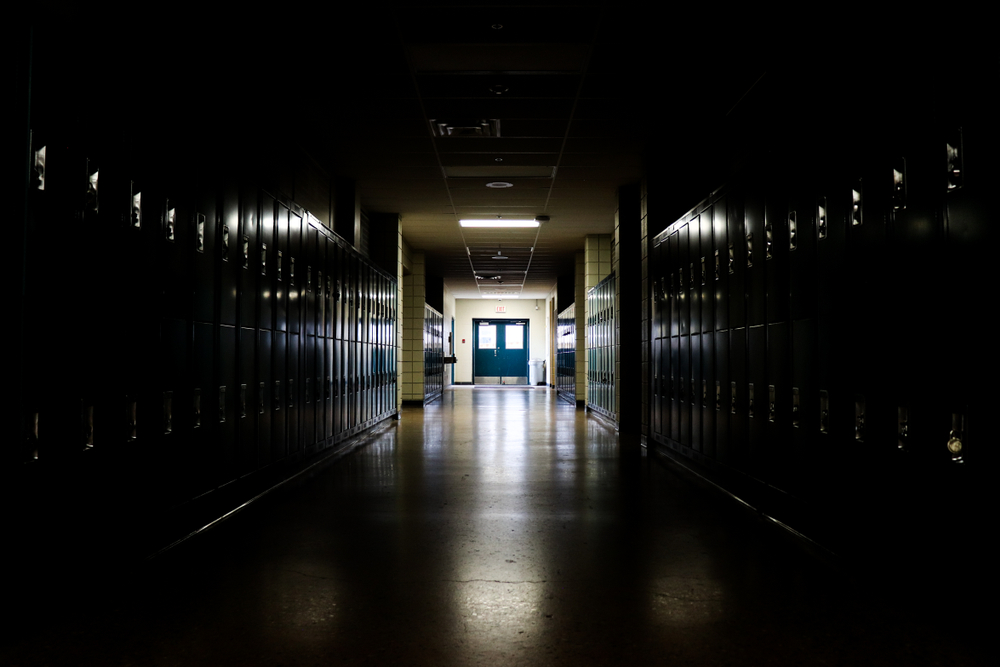There’s a currently a revolution erupting in public school districts across the country. For quite some time, students haven’t been learning, teachers haven’t been teaching, and educational leaders have only been making things worse. In response, parents have started speaking out at school board meetings, sounding off on social media, and voting out the old guard running these districts.
And the fight continues. But now parents and concerned educators have a book that can help them articulate their frustrations with public schools. Its writer, Luke Rosiak, found himself at the center of this firestorm by reporting on the scandals of the school system in Loudon County, Virginia. Unfortunately, he learned that the problems of Loudon County were also the problems of innumerable school districts all over the U.S.
In his book Race to the Bottom: Uncovering the Secret Forces Destroying American Public Education, Rosiak describes the dire situation of so many schools across the country and looks for the causes, which turn out to be legion. His book demonstrates how a toxic brew of Progressive activists, “anti-racism” advocates, teachers unions, Democratic politicians, and billionaire social engineers have managed the devastation of public education, whether that was their intention or not.
Rosiak begins with a disturbing description of virtual learning, in which young children were stuck staring at screens so many waking hours of the day while teachers did their utmost to prolong this charade of remote learning being the equivalent of in-person learning. Although the mediocre instruction and lack of accountability didn’t start with COVID, it became much more pervasive because of it: “One side effect of COVID-19 … was to remind Americans how central K-12 schools are to our lives.” This is true. Had Rosiak written on this topic before the pandemic, few people would’ve noticed since, as Rosiak himself puts it, “[K–12 education] was more or less on autopilot.” Consequently, so much Progressive indoctrination, poor instruction, and unprepared graduates were left untouched.
When looking at the data, however, it becomes clear that this complacency has done serious harm to public schools. By any metric, schools were faltering well before COVID, and even more so afterward. Unfortunately, rather than buckle down and find better instructional strategies, teachers and principals collectively denounced the idea of having standards in the first place in the name of fairness and equity.
Consequently, educators take aggressive issue with those who do fight for standards and actually look at the numbers. For example, Rosiak narrates the showdown between retired engineer Brian Davison and the Loudon County School District. Davison “asked for a copy of growth scores under the Freedom of Information Act,” but “Loudon County Public Schools (LCPS) told him that it did not have them.”
Davison made the mistake of following up on his request and sued the district for withholding this information. Instead of owning up to its mistakes and producing the requested documents, the LCPS school board members sought to destroy Davison and sicced law enforcement on him. Davison prevailed and found that there were, indeed, gaps between teachers whose students showed great improvement in their classroom and those whose students stagnated and even regressed, but nothing much came of this revelation.
This raises the question, If educational leaders and teachers unions don’t care about numbers, about their own effectiveness in the classroom, what do they care about? According to Rosiak, many administrators and teachers, particularly those in Virginia, New York, Illinois, Maryland, Washington, and California, seem intent on doing as little as possible and pushing leftist dogma. And COVID only made things worse.
Soon after shutting down for COVID, many left-leaning teachers and administrators exploited the George Floyd protests and riots, further pushing issues of race to the fore of educational policy. The time was ripe for school boards to declare that spreading “anti-racism” and guaranteeing equal outcomes among all racial groups should become the top priority for schools.
One of the most influential proponents of this effort was Glenn Singleton, an African American who attended Ivy League schools and lived, in Rosiak’s words, “a life of privilege, full of opportunity and success.” Instead of inspiring gratitude, Singleton’s experience growing up sparked a deep resentment with what he saw as white supremacist culture. This sentiment translated into his starting the Pacific Education Group (PEG), through which he would help various private prep schools deal with their supposed deep-seated racism. Eventually, PEG’s efforts resulted in a whole industry of anti-racist educational consultants.
In this kind of environment, it was only natural that critical race theory (CRT), the idea that all disparities in performance and achievement are the result of systemic racism, would become popular. Rosiak rightly notes that CRT simply ends up creating more problems than it solves: “Not only is CRT not a method for solving problems; it is a method for discovering them where no one had perceived them before.”
Even if the words “critical race theory” were never explicitly spoken, which was often asserted by its defenders, its underlying agenda was vigorously pursued throughout many districts, usually under the guise of ensuring “equity.” The already limited focus on education was quickly displaced by seeing any achievement gap among different races as evidence of racism and taking any and all means necessary to root it out. Rosiak tells the story of LCPS’s hiring equity consultants, who unsurprisingly, saw racism everywhere and used this claim as leverage to demand more “money, power, and the ability to further propagate critical race theory.”
In a short period of time, CRT consultants were to be found all over the country, spouting unsubstantiated claims and dubious remedies to imaginary problems. The sheer outrageousness of the whole movement was its greatest asset. Rosiak’s observation is telling: “If parents hear about these ideas at all, they presume that they must be hearing exaggerations, statements taken out of context, or the cherry-picked ideas of a few zealots, or assume that they are limited to inner-city schools. This is a fatal mistake. It is everywhere in the world of children’s education, and has been for years.”
Rosiak considers the often neglected question of who actually funds these anti-racism movements. First, there’s the government, which blithely shovels billions of taxpayer dollars toward activist groups as well as administrators and teachers unions. So if anyone wonders where Baltimore’s $19,063 per student goes, it’s to people who are more or less completely removed from the classroom.
Funding also comes from innocuous-sounding foundations engaged in social engineering. Many activists turned school consultants are patronized and promoted by a handful of large foundations, “primarily Ford; Gates; W.K. Kellogg; Annie E. Carnegie; MacArthur; and Surdna.” These people then go on to produce questionable scholarship, infiltrate local politics and media, develop trainings, and write curricula for teachers and professors to use. Even though these activists pretend to be “one of the people” fighting for social justice, nearly all of them are shilling for the world’s wealthiest elites.
Rosiak goes into detail about how the work of these foundations and their opportunistic puppets not only plagues school districts but also local governments. He examines how local politics becomes overrun with progressive urbanists who use the same buzzwords and phrases as their educational counterparts to destroy the suburbs. Like school systems, the suburbs are deemed racist and thus asked to take on the rot of the cities by providing high-density, low-income housing.
Naturally, none of this is the least bit democratic. Even if the rhetoric of these reformers suggests a focus on helping the poor, it is real estate developers and government agencies who really profit since they are the ones building and taxing these new residences. Rosiak compares this situation to the bootleggers who took advantage of the Progressive and evangelical campaigns for the prohibition of alcohol.
In the epilogue, Rosiak reveals his final assessment of the whole state of affairs. Not surprisingly, he fully condemns public education and recommends that people pull their kids out of public schools: “I’m fully convinced that finding virtually any alternative will be worth it, even if making it happen requires major life changes.” As parents do this, they can also push for various school reforms, though Rosiak is not exactly optimistic on this point: “I am no longer sure America’s public school system can be saved”
As with so many other conservative critiques of public education, this is the main weakness of Race to the Bottom: the lack of concrete solutions. This is especially frustrating for a teacher like myself who largely agrees with Rosiak’s diagnosis. He doesn’t even think much about school choice and charter schools, which he considers mostly a conservative copout from talking seriously about education. School choice may not equate to educational reform, but it’s the necessary basis for reform. It’s the equivalent of pulling the fire alarm.
Another weakness is Rosiak’s style of argument, which is mainly reporting on the very worst examples happening across the country. Rather than delve into the purpose and meaning of education as a way to frame his argument and explore deeper issues at play, so much of his argument rests on basic conservative assumptions: More parent input and standardized testing is good, teachers unions and efforts to fight inequity are bad, schools just need to teach the 3 R’s, etc. These assumptions aren’t necessarily false, but they tend to leave out important factors of pedagogy, community, and culture, which determine much of what happens at public school classrooms. Outrage alone can only go so far.
Nevertheless, too much of Rosiak’s book sadly rings true. Americans have a particular blind spot about education, which Race to the Bottom can remedy. It’s beyond foolish to believe that kids can make it through today’s schools unscathed by political indoctrination and rampant mediocrity. They are coming out woefully unprepared to take on basic responsibilities of adulthood, and their future is significantly diminished, all because the adults in their lives didn’t think to question what was or wasn’t happening in the places their kids spent so many hours five days a week of the most formative time in their young lives.
All this needs to change right away, if not for today’s students, then for subsequent generations having to pick up the pieces. At the very least, readers should heed Rosiak’s warning to wake up and start paying attention to what’s happening not only to our educational system but to our civilization: “For the sake of our kids’ happiness, for the sake of our constitutional republic, for the sake of a modern world fueled by scientific and technological advancement, we can never, ever go back to sleep.”

